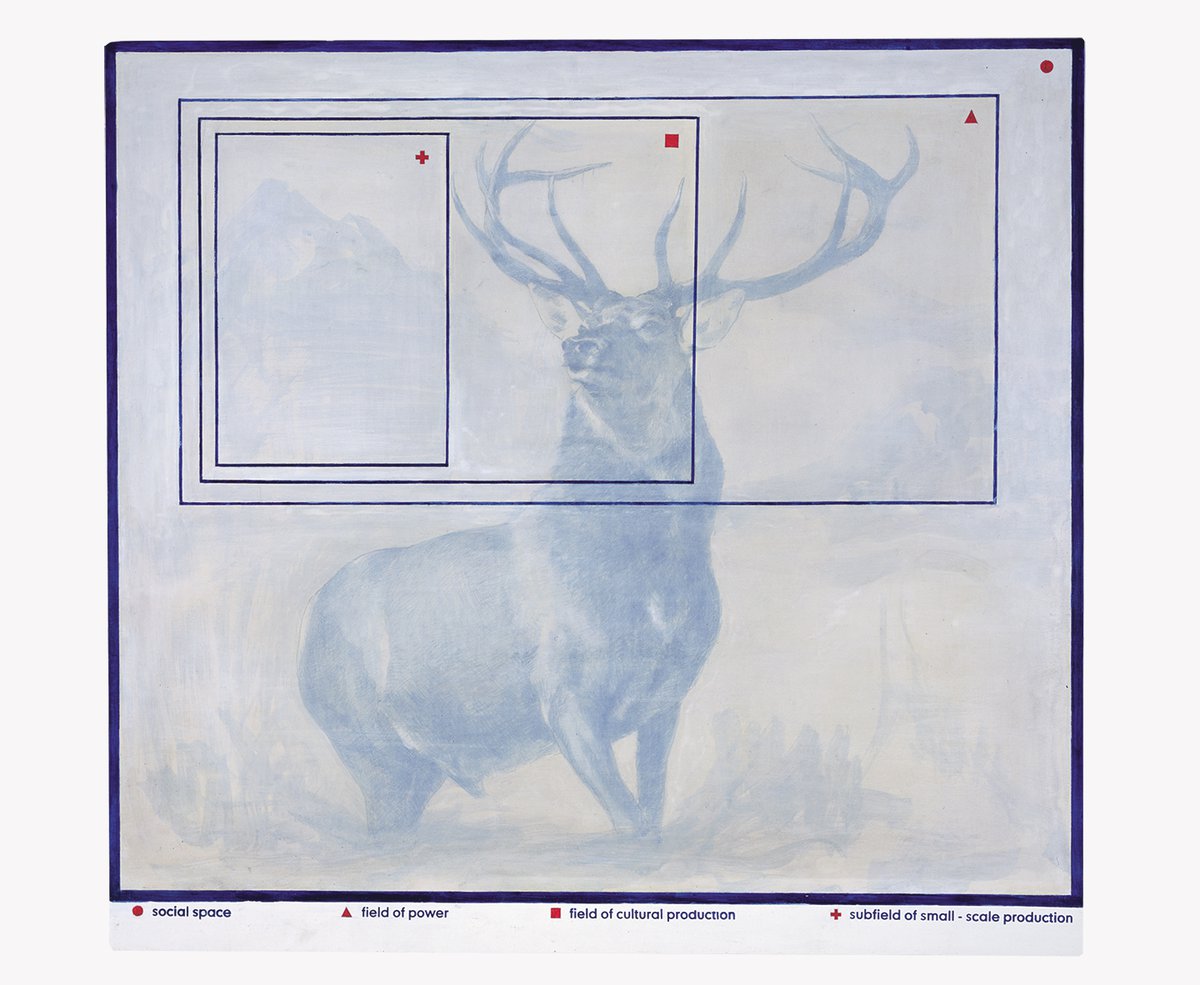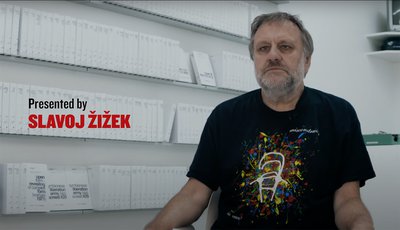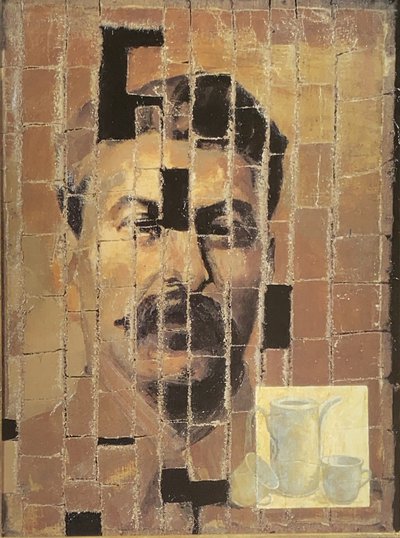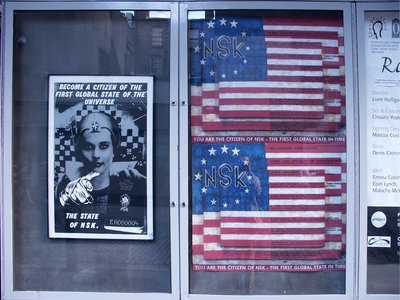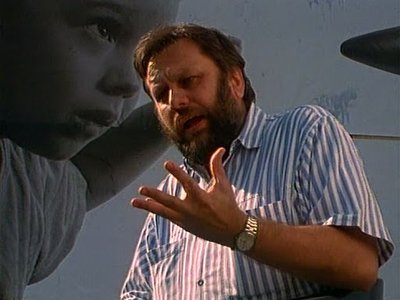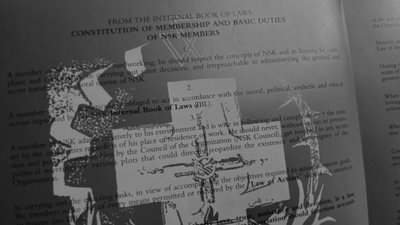Terror as Therapy/Therapy as Terror
Theory as Terror/Theory as Therapy
LAIBACH - IRWIN - STATE
"Laibach itself does not function as answer but as a question."
Slavoj Zizek.
LAIBACH
What is the best approach to exploring what Laibach, Irwin and the NSK State represent? Fundamentally the work of all NSK groups represents an artistic and also cultural response to the imposed violence of ideology, culture and theory. This perception of violence is present most acutely in Laibach's initial reprocessing of language and ideology and to see how the machine operates it's necessary to return to these traumatic roots.
When someone is confronted by Laibach what they are actually confronted with is Laibach's confrontation with the series of political and cultural regimes and systems that structure our environment and which Laibach confront. Whilst Laibach might seem like the ultimate mechanism for imposing ideology it is actually one for exposing it.
Laibach was created to "explore the relationship between art and ideology" and was an attempt to create a counter-mechanism able to retrieve meaning from the overwhelming contradictions of politics and culture. Laibach distilled a series of competing Western and local theories present in Yugoslavia. By 1980 Western philosophy and theory were increasingly influential amongst the intelligentsia, and different authors became associated with different Yugoslav "schools" and institutions. This trend affected the Yugoslav party and even the army. Soviet thought was treated with suspicion because of the legacy of the break with Stalin in 1948 and the party's desire to differentiate itself from Stalinism. All these ideologies supplemented and existed in parallel with the all-pervasive self-management discourse (itself an eclectic mixture of various ideologies), which was a constant presence within all social institutions.1 Zizek depicts a situation in which the various philosophical schools were in competition, within and between the Yugoslav republics.2 According to Zizek the paramount schools within Slovenia were Heideggerianism amongst the opposition and Frankfurt-School Marxism within the party. In between these two lay an Althusserian school attacked by both camps and the near-taboo Slovene Lacanian School centred on Zizek. These ideologies structured the discourses through which the different institutions communicated with the public and Zizek notes for instance that the army's justifications of its military-ideological doctrines ("General People's Defence"3 ) employed Heideggerian language. This institutionalised ideological cacophony amplified the oppressive aspects of each theory, creating an infinitely more complex reality than in other socialist states. If Yugoslavia failed it was as much because it was too complex as too primitive.
Laibach and then NSK alluded to and incorporated elements of most of the principal theories and "recapitulated" the terror instilled in the subject by tautological and contradictory discourse.4 Laibach fused the competing theories into its own distinctive language. Adorno's critique of popular culture is strongly present in Laibach statements but its pronouncements on the role of the mass media also incorporate the work of Althusser and Jacques Attali and both Hegelian and Heideggerian traces are apparent in the texts of the NSK Philosophy Department.
Laibach created what it called "political poetry" by "sampling" official self-management discourse, even appropriating statements by Tito (as well as his image). In fact Tito has enjoyed a strange after-life in the work of NSK and various other ex-Yugoslav artists, and in the late nineties one artist even arranged for Tito to walk the streets of Belgrade once again. The ruling discourse in Yugoslavia was simultaneously ubiquitous and invisible. Laibach was able to appropriate the codes of self-management ideology precisely because almost no-one, party ideologues included, had actually read its core texts in any detail. The ideology was still active but awaited a use. Zizek claims that in practice developed totalitarian ideology has abandoned pretensions to the truth: "It is no longer meant, even by its authors, to be taken seriously - its status is just that of a means of manipulation, purely external and instrumental; its rule is secured not by its truth-value but by simple extra-ideological violence and promise of gain."5 Laibach took the dominant feature of the normative politico-linguistic environment and made it strange by juxtaposing it with a wide range of other contradictory discourses and artistic techniques. These ranged from Fluxus art and conceptualism to Nazi and Stalinist art then on to Punk and electro-acoustic music. So again while Laibach appears to be a total, monolithic phenomenon it is actually composed of what Zizek calls an "aggressive inconsistent mixture". To fix upon and condemn (or alternatively celebrate) any one (shifting) ideological point within it is fatal since as Zizek states in contemporary politics it is often a "...mistake is to suppose that the fascists are fascists, that they behave like fascists."6 By never revealing a final cause or programme, this plural monolith translates re-processes the alienation and fear generated by what it samples, returning them to their sources. Laibach generates a de-stabilising effect by turning the de-stabilsing, unresolved elements of each system against themselves.
The NSK strategy is particularly oriented towards rendering visible/audible/ perceptible what Zizek7terms the "hidden underside" of systems and regimes. Within every system there is always an excessive element that can often frustrate or incapacitate a system if it is revealed.8 This can manifest as contradiction, inconsistency, paradox or even excessive self-identification of the system. All these normally concealed elements, essential to the normal functioning and reproduction of ideology are the basis of NSK operations.
In a superficially-tolerant and pluralist environment which is actually saturated by ideology (or as now by the market), traditional dissident approaches are of limited value. To really de-stabilise authority it is sometimes necessary to go beyond or behind it, to annexe the space it cannot publicly admit to owning. To understand what this implies we need to depart from orthodox Zizekism and bring in the work of Gilles Deleuze and Felix Guattari9 , both criticised by Zizek. In their seminal work on Kafka, Towards a Minor Literature, Deleuze and Guattari interpret what they call the "becoming-animal" process in Metamorphosis as an answer to the inhumanity of the (bureaucratic) machineries that were increasingly impinging on daily life at the start of the 20th century. Laibach's response to similar conditions was based on becoming in Zizek's terms, "more x than x itself", becoming-systemic/state/ or machine-like – apparently colder, more systematic and ruthless than the system itself. In addition it means manifesting the repressed totalitarian desires of a system.
Straying even further into Deleuzian territory we could describe Laibach's approach as an example of what Deleuze and Guattari term "schizoanalysis." That is, Laibach use the schizoid reactions produced by the imposition of ideology and culture to analyse these impositions. In order to analyse these intangible and spectral elements it's necessary to construct the illusion of a total phenomenon, an interrogation machine capable of interrogating the mechanisms that interrogate the subject. For over-identification to be effective it has to (appear) total. Over-identification transcends and symbolically re-activates the terror of the social field (as structured by the regimes that shape it). The spectre of totality gives the phenomenon sufficient "credibility" to sow doubt and disquiet (as well as fascination). Sufficient "evidence" has to be present to activate social and ideological defence mechanisms.
Every element in Laibach is a metaphor and a private archetype of the systems it interrogates. For instance, the use of noise in Laibach's work reflects generalised social and cultural violence inflicted by the mass media and music industries. Laibach manipulate and perform such systemic violence or "regime noise" against audiences and regimes alike with a ferocity approaching the intensity of electro convulsive therapy (ECT).
"LAIBACH practices sound/force in the form of a systematic (psychophysical) terror as therapy and as the principle of social organisation.
Purpose: to provoke maximum collective emotions and release the automatic response of masses;
Consequence: the effective disciplining of the revolted and alienated audience; awakening the feeling of total belonging and commitment to the Higher Order;
Result: by obscuring his intellect, the consumer is reduced to a state of humble remorse, which is a state of collective aphasia, which is in turn the principle of social organization"10
Added to this sonic and physical violence is a linguistic and conceptual violence that
evokes Francoise Thom's description of linguistic totalitarianism and its use of what she calls "...pedantry as a means of intellectual terrorism".11 Laibach's use of language is terroristic in that it is explicitly designed for use as a disorientating, alienating device as violent as its sounds and images. Laibach's language is designed both in its associations and its mode of expression to be oppressive, an analogue to the violence of the concerts. Asked in one early interview about their bureaucratic mode of communication Laibach explicitly stated that their work is based on the linguistic-conceptual terror of ideology:
"Such a form of interview is the limit of comprehension, within which the subject is prevented from feigning ignorance and communication through non-communication. The way of its formation is simultaneously also a process of permanent repression on linguistic models, and thereby, also on the subjects which construct them. Such a form reduces the possibility of individual influences on the structure of the expression itself to a minimum; it is dictated through the totalitarian structure and understood as the right to incomprehensibility. (LAIBACH thus constantly degrades every communication on the level of the word, turning it into ideological phraseology). The assimilating capacity of the consumer is limited and depends on:
a: the knowledge of the symbol(s)
b: the level of development of the consumer
c: the technique of perception (speed-reading)
The consumer can only influence the third factor; LAIBACH recommends a selection of sources of information."12
This last recommendation actually represents a coded instruction to educate yourself, to follow the connections and attempt to reconstruct the context of what you are presented with. As some of us know, following Laibach means following all manner of sources, exposing yourself to the diverse elements in order to re-construct meaning and not simply remain a passive victim of spectacle. At the same time, Laibach's "right to incomprehensibility" expresses one of the clearest features of its work, a defence of ambiguity and of the right not to have to explain every detail of an artistic process or adopt clear political stances. Besides ambiguity, Laibach in its texts, images, music and concerts also allows for simultaneity. The texts refer simultaneously to several sources and associations and deliberately leave the resulting paradoxes to be resolved by the "consumer". They are oriented towards a series of regimes and adopt the linguistic and other codes of these regimes in order to render perceptible characteristics normally kept hidden by such regimes.
However its important not to overlook the kitsch and humorous elements also present in Laibach and to be aware of a humane undercurrent within what seems to be a reactionary format. A constant theme in the first years of Laibach's work was exorcism, referred to directly in the track Vade Retro Satanas and Laibach's work could even be seen as a type of exorcistic bewitchment, a counter-spell for the spells cast by ideology. "Explaining" its approach at the time Laibach stated:
"Our appearance has a purifying (EXORCISM!) and regenerative (HONEY AND GOLD)13function. With a mystical erotic audiovisual constitution of the ambivalence of fear and fascination (which acts on the consciousness in a primeval way), with a ritualized demonstration of political force, and with other manipulative approaches, LAIBACH practices sound/force in the form of a systematic (psychophysical) terror as therapy and as principle of social organization."14
Going beyond Laibach's "terror as therapy" and reversing it we reach the formula "therapy as terror", which brings us back to Zizek. Laibach's alienating, mystifying language, which incorporates psychoanalytic theory, also suggests the totalitarian underside of therapy when used to normalise pathologies produced by phenomena such as ideology, culture and theory. To the uninitiated, Lacanian and similar theory can appear as terror, manifesting people's fear of complexity. However to the initiated, a group that Zizek has vastly enlarged, theory can also work as if not therapy, then as a strong cultural diagnostic tool. So it is within this block,
Terror as Therapy/Therapy as Terror
Theory as Terror/Theory as Therapy
that Laibach and Zizek oscillate. Both use the appearance of extreme means to generate illuminating and destabilising responses from the terror/therapy/theory matrix and both use theory transgressively and imperiously to bewitch, mystify and illuminate their audiences.
IRWIN
In Irwin's work we initially see similar aesthetic terror tactics to Laibach, the transmuting of Laibach’s ambivalent imagery into visually dense and semiotically overloaded "icons" designed to captivate the onlooker. The icons were cross-media intensifications of already powerful and traumatic Laibach images transferred to new spheres. The Slovene art historian Tomaz Brejc wrote in 1992 of Irwin that:
"They have equated the cross with a hunting trophy, high art with kitsch, the avant-garde with Biedermeier... The IRWIN however, are totally committed to the functional reality of the total. Spectacle is their style for they are aware that there is no need to believe in it because it convinces the viewer by force."15
In addition Irwin retained the collective structure, attributing work to the group and not the individual and also using intimidating or mystifying and sometimes mystical language, if never quite as extreme as Laibach's. However, while Laibach still has to continually re-create distance from systems, Irwin now work more subtly, approaching power in a lighter, more playful, but still interrogative mode. Irwin move from the monumental to the (apparently) frivolous and like Laibach often simultaneously flirt with kitsch.
Irwin now embrace and reflect the contemporary proliferation of media, moving into installation, performance and digital practice, interrogating more via seduction than intimidation. Even so, NSK's ambitious approach to the totality of power is still apparent, for instance in Irwin's NSK Garda projects, where uniformed troops of various states parade wearing Laibach style black cross armbands. So even at their most "user-friendly", Irwin still symbolically reject passivity in relation to the coordinates of "actually existing" reality. This can be seen in Irwin's move towards self-narration and self-curation and the attempt to use their position as internationally-recognised "Eastern" artists to turn this still-pejorative label into a virtue. Irwin have begun to auto-narrating the recent history of East European art rather than waiting for it to be absorbed into Western paradigms.
Irwin's final mode of interrogation is to deploy what can be seen as a "resurrection dynamic" that is also present in Laibach and other ex-Yugoslav art. By symbolically and inconveniently resurrecting lost revolutionary figures such as Tito and Malevich (whom Irwin brand "the corpse of art"), Irwin are asking who has the right to declare that a regime or style has passed into history or, for that matter, that history has ended?
Irwin have previously spoken of their concern to "produce time" and time is also becoming an increasingly overt theme in Laibach's late work. Irwin's multi-layered, multi-temporal paintings and installations are effectively viral artefacts - artefacts as temporal viruses containing embedded disruptive codes. The viral (active) elements are the traumatic and spectacular archetypes used to generate dissonant conceptual energy. Irwin icons simultaneously bring forward supposedly defunct symbols (totalitarian or national motifs) and drag back supposedly contemporary, modern elements (pop art, contemporary design or packaging).
Such a process is inimical to stability since systemic order depends not purely on the concealment and defence of source codes and archetypes but on a kind of temporal cleansing. Old data or icons that would conflict with the current program imperatives have to be removed and operators have to be vigilant against a build-up of debris accumulated from previous operations. Yet what NSK work from is precisely the restoration of material that should have been deleted, de-activated or obscured in order for the system to continue smooth operations in the present.
Restoring such "dead" material to "live" status works as a kind of data forensics, re-instating compromising or incriminating evidence. Irwin's 1991 installation The Golden Age (Stedelijk Museum, Amsterdam) was a particularly acute example of this. Just as Slovenia broke with a Yugoslav federation that was still nominally socialist and re-launched itself as independent Western-style democracy Irwin re-activated the discarded symbols of the old regime. At the centre of the work are five wall signs for local offices of the Yugoslav Communist Party taken from across Slovenia, including Ljubljana and Trbovlje. This conflicted with the nationalist historical agenda in Slovenia, which sought to erase traces of the recent socialist past and present it as a foreign, un-Slovene deviation. This retrogarde16 strategy interrogates contemporary stylistic and political regimes through a return to styles and moments relegated to obscurity by political correctness or changing fashion, both of which are often actively suspicious of archetypes per se.
STATE
"The Lacanian answer to the question: From where does the repressed return? is, therefore, paradoxically: From the future... As soon as we enter the symbolic order, the past is always present in the form of historical tradition and the meaning of these traces is not given; it changes continually with the transformations of the signifier’s network. Every historical rupture, every advent of a new master-signifier, changes retroactively the meaning of all tradition, restructures the narration of the past, makes it readable in another, new way."17
Shortly after Irwin resurrected Communist symbolism and Slovenia gained independence, NSK carried out its ultimate distancing action, the NSK State in Time, the result of its previous interrogations of other systems and the endpoint of the "becoming-state" process. Without this step NSK would have been claimed for the Slovene nationalist narrative as artists interested only in the triumph of the Slovene political project, the NSK process would have re-materialised and become static when in fact it has always been in motion. As some American critics observed in 1992:
"Icons originally designed to make statehood seem eternal and omnipotent are defined in Irwin's work as a series of moments rather than as a total and ongoing condition."18
With the device of the state NSK maintained temporal, conceptual and territorial autonomy within it’s own space and opened a symbolic system of autonomy across national borders. For NSK, Yugoslavia and the notion of the state were the ultimate conceptual and artistic "ready-mades" for re-processing and re-construction. NSK became state using the utopian and dystopian dynamics of the Yugoslav state, appropriating the Balkanizing dynamic it contained and incubated and presenting the only positive conceptualisation of "state" to survive Yugoslavia’s death. NSK also played on the post-1989 confusion of new states, sub-states and the resurrection of supposedly dead states and national state projects. In the chaos of the mid-nineties the emergence of one more obscure "Eastern" state was unremarkable and quite plausible, so much so that people have travelled successfully using NSK passports.
At a moment when history was being de-written and re-written day to day, even according to shifts in front lines, it was natural for NSK to intensify the process of temporal manipulation. The national histories of the "new" post-1989 states underwent systematic revision and reconstruction in this period and as ever this was linked to totalising if not totalitarian political forces. Where NSK's approach differs from this political resurrection dynamic is that the manipulation is on the surface. NSK has never concealed the fabrication of its history and until recently there was no systematic external history of NSK. NSK openly recapitulate the totalitarian dynamic of reconstructing the past to fit the future. This dynamic is of course also present (though rarely seen on the surface of) our own media and its constant reprocessing of history.
Again, the question is since retroactive falsification and manipulation of the past and of images are systematic imperatives of the media and governments why should NSK or similar autonomous groups not re-appropriate these tactics against such regimes? The new nationalist and corporate histories are streamlined, accessible and simplified whereas NSK's history is built on paradox and retroactivity, the retroactive synthesis of meaning. So looking back from the perspective of the NSK state we can see all the previous NSK works as leading towards the state as an inevitable, inherent project. NSK's state is composed of the totality of all previous NSK works and the interrogated systems they incorporate. The NSK state issues an explosive challenge - who now has the right to declare or refuse to recognise a state and how do we respond to the compromises and demands of all "given", "actually existing" statehoods?
NSK appropriated both the utopian and dystopian extremes of the notion of state. Our actually existing managerial market-states have disowned the protective, idealistic aspects of state power in favour of bland pragmatism. At the same time they publicly disown and condemn totalitarianism "elsewhere" while racing to enforce biometric passports and mass electronic surveillance. Open totalitarianism is being replaced by banal market-state authoritarianism, with the potential to become infinitely more total than the "old" totalitarian states. In these conditions it is more critical than ever that there should be framework incisive and imaginative enough to interrogate these forces and the cultures that support them - the interrogation machine remains the most effective counter-spell to the spells cast by power.
"... today the concept of utopia has made an about-face turn - utopian energy is no longer directed towards a stateless community, but towards a state which would no longer be founded on an ethnic community and its territory, therefore simultaneously towards a state without territory, towards a purely artificial structure of principles and authority which will have severed the umbilical cords of ethnic origin, indigenousness and rootedness."19
References:
Mark Thompson, A Paper House The End of Yugoslavia, 1993, 39. (London: Vintage. 1993).
Slavoj Zizek, Tarrying With The Negative Kant, Hegel and the Critique of Ideology. (2nd edit.) (Durham: Duke UP 1994,) 192-3.
This doctrine was based on a constant state of low-level psychological mobilisation of the population In the event of war the population was to confront the invader with partisan tactics based on elaborate planning and pre-positioned weapons stores. This structure formed the material and tactical basis for the rival paramilitary groups of the nineties.
See Erika Gottlieb, The Orwell Conundrum A Cry of Despair or Faith In The Spirit of Man? (Ottawa: Carleton University Press, 1992) 156-7 and Francoise Thom, Newspeak The Language of Soviet Communism. (London: The Claridge Press 1989,) 115.
Slavoj Zizek The Sublime Object of Ideology, (London: Verso 1995, 5th edit.), 30.
From an interview featured on the Laibach Bravo video.
Slavoj Zizek, Why are Laibach and NSK not Fascists?. M’ARS. Vol. 3-4. (1993), 3-4.
Ibid. Zizek argues that NSK suspend the efficiency of regimes by over-identifying with their hidden aspects (for instance the latent totalitarianism of the Yugoslav system).
Gilles Deleuze and Felix Guattari, Kafka, Towards A Minor Literature. (London: Athlone Press, 1996), 12.
NSK, Neue Slowenische Kunst. (Los Angeles: AMOK Books, 1991.), 44.
Thom 1989, 22.
NSK 1991, 52.
13 A Beuys reference, these materials are used in some Irwin pieces.
NSK 1991, 44.
Brejc, T. 1992, Slovene Images in Huttenbach, H. (Ed.) Voices From The Slovene Nation. Nationalities Papers Special Edition. 142-3.
The three founding NSK groups each have their own specific retro terminologies. In 1982 first Laibach began to use the philosophical/conceptual term "retroavantgarde". The Theatre of the Sisters of Scipion Nasice used the term "retrogarde" (conceptualised as a social & cultural movement) whilst Irwin described their methodology as the "retro principle".
Zizek 1995, 55-6.
J.C. Finley, Barrett Watten, IRWIN: A Dialogue in IRWIN Kapital. (Edinburgh/Ljubljana: CO-LABORATOR/Institut NSK, 1991).
Slavoj Zizek, Es Gibt Keinen Staat in Europa (There is No State In Europe), In Irwin, Padiglione NSK (NSK Pavillion) (Ljubljana: Moderna Galerija 1993).
